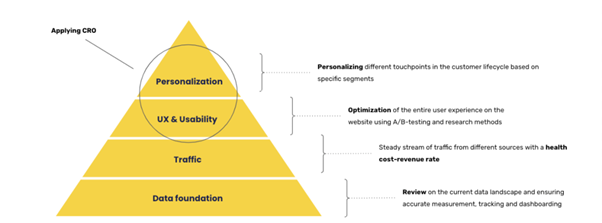While website optimization, achieved through A/B testing and various research methods, represents a more commonly practiced approach, personalization is still emerging. We definitely see more companies embracing Conversion Rate Optimization (CRO), testing and research. But in terms of personalization, it’s safe to say that most organizations are yet to fully harness its potential. This article discusses why having a strong CRO program is essential for personalization and how these two practices can benefit each other.
Differences and similarities
The primary distinction between optimization and personalization lies in their respective objectives. Optimization seeks to enhance the user experience for all website visitors, while personalization aims to tailor the experience to specific segments. The crucial divergence lies in how hypotheses are formulated. Personalization necessitates a clear understanding of the target audience, diving deeper than general A/B tests focused on the entire population. Although the latter also requires consideration of visitor needs and preferences, it is less specific.
Another difference lies in the implementation process. After an A/B test in optimization proves successful, the changes can be directly applied. In contrast, personalization relies on segmentation through a Customer Data Platform (CDP). Consequently, a hard-coded implementation is often impractical, and the personalization continues through the CDP, as it relies on creating visitor profiles and segments to effectively target them.
Despite the differing goals, the working methodologies are, or at least should be, similar. Learning through testing is fundamental to both approaches. Hypotheses are grounded in theory or research, whether qualitative or quantitative. A test plan is formulated, encompassing clear KPIs, target demographics, and the expected duration of the test. Subsequently, a test is developed, launched, and followed by a thorough analysis. However, the extent to which this process is adhered to in personalization can be a subject of debate.
How they can collaborate
Optimization and personalization should work together. As illustrated in the pyramid, we consider personalization as the ultimate phase in e-commerce. Prior to delving into personalization, it’s imperative to establish a solid foundation of usability, which is accomplished through optimization. Even the most sophisticated personalization efforts can’t salvage a poorly performing website. Defining baseline usability can be somewhat elusive, but it essentially involves ensuring a website is free of glitches, implementing best practices, and addressing major obstacles in the checkout process. Furthermore, this baseline encompasses developing a comprehensive understanding of your customers’ desires, needs, and the factors impeding conversion.

When an organization is prepared to engage in both general optimization and personalized experiences, it becomes essential to ensure that these activities are in sync. For instance, let’s imagine running an A/B test on the product page for all website visitors, and it fails to produce the anticipated improvement. However, a closer analysis reveals variations in test performance among different segments (such as devices, the number of pages viewed, new/returning users, and traffic sources). This situation opens the door to personalization, where the same adjustment on the product page can be retested on a specific segment. The reverse scenario is also plausible; if a personalization A/B test proves successful within a particular segment, it can be considered for implementation across the entire website user base, albeit with the necessity of conducting initial tests.
Furthermore, alignment is crucial to prevent conflicts between traditional A/B tests and personalization A/B tests that may inadvertently run simultaneously. While this might seem straightforward, things get easily tangled up when different teams or individuals are collaborating.
How personalization can evolve
Previously, we emphasized that the working methods between optimization and personalization are, or should be, quite similar. However, the motivation behind this article is the observation that in many companies, these similarities often do not hold true. CRO practices, such as formulating well-founded hypotheses, conducting user research, implementing SRM checks, or performing in-depth test analyses, are not standard procedures within personalization projects.
A more pressing concern is the fact that systematic A/B testing is not yet a widespread practice in many organizations. Personalization initiatives are frequently launched without validating their impact or testing the optimal means of visualizing or presenting the personalization. Additionally, we have noticed that some organizations carry out random personalization experiments without a clear strategic framework behind them.
When starting with personalization, it is crucial that the organization has a strong CRO program in place. This entails not only having a well-defined process that encompasses research, ideation, test development, and analysis but also necessitates the establishment of a clear strategy. This strategy should outline how both optimization and personalization can contribute to achieving the business goals or targets. Failing to establish such a strategy runs the risk of investing considerable time and effort on things that may ultimately not contribute to overall success. Although single personalization efforts can be effective, when all personalizations work together toward a shared goal, the chances of achieving better results are higher.
To sum up
Many organizations are increasingly embracing CRO, which includes both optimization and personalization. However, there’s room for improvement in how organizations approach this. The crucial factor is to understand the distinctions and subtleties of personalization while maintaining a process similar to traditional CRO. Most importantly, personalization should not be isolated but rather integrated with optimization and extend where the other leaves off. All these efforts should align with a long-term strategy that leverages experimentation to contribute to business goals.
Author: Nick Schaperkotter, Team Lead CRO & Design at Yellowgrape.
